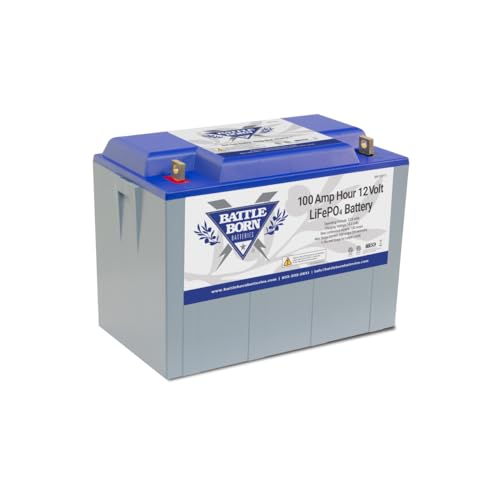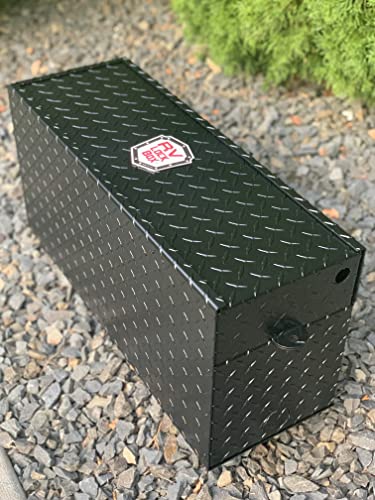Table of Contents
You may be wondering what a deep cycle battery is.
Deep cycle batteries are built to be charged and recharged repeatedly. A deep cycle battery, as opposed to providing a burst of energy for tasks such as starting a vehicle, offers a constant trickle of power over a lengthy period of time.
These batteries, which are available in four basic forms, are notably useful in RV coaches, golf carts, and maritime applications.
Best Deep Cycle Batteries for RV
The Different types of batteries
Ion Lithium
Electrons in a lithium battery flow back and forth from anode to cathode to generate a charge in a solution of lithium salts. This deep cycle battery can be nearly entirely depleted without consequence and has the fastest recharge rate of any battery type.
They weigh almost half as much as lead-acid batteries. All of these features combine to make them some of the best RV batteries for boondocking.
Pros
- Usable capacity ranges from 80% to 100%.
- Charge rates that are extremely high
- There is no need for maintenance because there is no battery memory.
- It is light.
- Charge cycles ranging from 2,000 to 5,000
Cons
- The most costly deep cycle battery option
- At low temperatures, charging is not possible (but it still performs better at low temperatures based on Battle Born Batteries Whitepaper)
- A battery maintenance system is required (usually internal)
Time to Charge
- Time to charge a lithium battery: 2 to 3 hours
Lithium-ion batteries are not the same as lead-acid batteries, whether sealed or flooded. Lithium batteries still have a cathode and anode, but lithium ions travel between them, usually in a solution of lithium salts.
Lithium battery cells come in a variety of shapes and sizes, including big and tiny cylinders (such as the ubiquitous 18650, 26650, and 32650 cells), soft plastic pouch cells, and plastic rectangle prismatic cells.
Lithium batteries come in a variety of chemistries, with the lithium iron phosphate battery being one of the safest, most stable, and longest-lasting options for RV use.
In comparison to other commonly used lithium battery types (such as lithium cobalt oxide batteries used in cell phones and laptops), lithium iron phosphate has a slightly lower energy density but is much less prone to thermal runaway, has a very flat discharge curve, and has the longest life of any lithium chemistry if well-maintained with good charging practices and moderate temperature.
There is no off-gassing, and these batteries can be depleted almost fully without causing long-term damage. They are also half the weight and less than half the volume of flooded lead-acid batteries, and they can accept extremely high charge rates (for example, 100A for a 100Ah battery).
Lead Acid Flooded
These deep cycle batteries are made up of lead plates that form “cells.” Each cell is filled with distilled water, which serves as the transfer substance and must be replenished on a regular basis. Lead-acid batteries are charged in phases, which leaves the possibility for complications such as overcharging or undercharging.
They are usually the cheapest option for a house battery and can be recharged multiple times, although they have a shorter life than AGMs and lithium batteries.
Pros
- the least expensive
- dependable tolerator of overcharging
- Can provide a high current
- It’s sold all throughout the world and is very easy to find.
- Shelf life is indefinite.
Cons
- Usable capacity ranges from 30% to 50%.
- Extremely heavy
- Monthly upkeep is required.
- Gases are discharged with a charge efficiency ranging from 70% to 85%.
Time to Charge
- Time to charge a lead acid battery: 8 to 16 hours
Overcharging, regular charging, and undercharging all have the following consequences:
- When a battery is overcharged at a high voltage, electrolysis occurs, which decomposes the water into its main components of hydrogen and oxygen gas (this is referred to as “off-gassing”). Overcharging with an equalization charge is sometimes used to recover undercharged flooded lead-acid batteries to a fully operational state.
- To keep a lead-acid battery completely charged, it is best to charge it in stages, usually with a bulk charge, an absorption or “topping” charge, and then a float charge. Even during normal charging, some off-gassing occurs, which is why lead-acid batteries require regular top-ups with distilled water. If this maintenance is not carried out, electrolyte levels can fall low enough to expose the plates, resulting in irreversible damage.
- Inadequate charging, on the other hand, has the temporary consequence of not getting the battery up to full charge and sustained inadequate charging can also lead to acid stratification, which is characterized by a layer of thicker electrolytes and layers of highly diluted electrolytes.
Gel
These deep-cycle batteries, like AGMs, require no maintenance. They move electrolytes via a gel material made of sulfuric acid and silicate. They don’t produce gases.
Thus, no ventilation is required for the batteries, but their charging rate is quite slow. These batteries can be found in electric wheelchairs and scooters.
Pros
- It does not leak.
- There is no need for upkeep.
- There is no off-gassing.
- Heat tolerance Charge efficiency of 85 to 90 percent
Cons
- More expensive than lead acid or AGM
- Cannot stand fast charging
- Overcharging has the potential to damage it.
- It has its own profile and setting.
Time to Charge
- Charge time for gel: 5 to 10 hours
Glass Mat Absorbent (AGM)
The electrolytes in these deep cycle batteries travel through fiberglass between the plates of their cells. It is a “dry” battery, which means it requires no maintenance because it does not require distilled water.
Their recharge rate is substantially faster than that of a lead-acid battery, but it is not as fast or efficient as that of a lithium battery.
Pros
- Usable capacity ranges from 60% to 80%.
- Charges at significantly higher rates than lead acid or gel Do not spill
- There is no off-gassing.
- There is no need for upkeep.
- 95 percent charge efficiency
- Cold temperatures have no effect on it.
Cons
- More expensive than lead acid
- Overcharging has the potential to damage it.
Time to Charge
- Time required to charge an AGM: 5 hours
Maintenance
With the exception of lead-acid batteries, all deep-cycle battery types do not require any maintenance. To maintain the plates in each cell immersed, distilled water must be topped off in lead-acid batteries on a monthly basis.
Failure to do so renders the plates worthless, and the battery must be replaced.
If you are not going to use the batteries for an extended period of time, a trickle charger can be used to keep them charged. It is not necessary to utilize it with lithium batteries because they have their own internal battery management system.
Installation
The installation of deep cycle lead-acid, gel and AGM batteries is the same. Simply connect the positive terminal to the positive wire from your coach and the negative terminal to the negative or ground wire from your coach, or if you have two or more batteries, wire them in parallel or series, depending on battery size (12 volts or 6 volts).
Lithium batteries are connected in the same fashion (positive to positive, negative to negative, or ground), however, your RV will require a lithium-specific converter (charger). If your equipment already has a converter, make sure it can work with lithium batteries.
Due to the voltage required, most ordinary converters will not be able to charge the lithium battery completely to 100 percent but will be able to charge to roughly 80 percent full.
How Long Do Deep Cycle Batteries Last?
A good deep-cycle lithium battery should endure between 3,000 and 5,000 charging cycles. So, depending on how frequently you recharge them, they might last anywhere from 3 to 20 years! Lead-acid batteries can last up to 6 years if properly maintained, while AGM batteries can last up to 6 years as well.
Gel batteries can last 10 to 20 years because they have their own charging profile.
Option for Solar Charging
Solar panels can be used to charge any sort of deep cycle battery. To regulate the charge, solar systems often include a solar charge controller between the panel and the batteries.
Most systems also feature a solar monitor, which allows you to see how much electricity the solar panels are producing and how much is remaining in your batteries.
FAQs
Where should the RV battery bank be located?
We recommend that you install your RV home battery bank in a sealed battery box within your camper van, preferably vented to the outside (lithium batteries do not require a sealed or vented box). If you keep your batteries at room temperature, not cold or hot, they will last a long time.
Having an inside battery bank will help reduce the lengths of your wiring lines, keeping voltage drop low and saving you money on materials.
How can I connect batteries together?
Batteries can be connected in series or parallel, depending on whether a specific voltage is required for the battery bank. Most RV battery banks are 12-volt banks, which means they have either two 6-volt batteries put in series or two 12-volt batteries wired in parallel.
Many 6-volt deep-cycle lead-acid batteries feature thicker plates than 12-volt deep-cycle batteries, which allows them to live longer. Batteries should be physically connected using very thick battery cables that are sized appropriately, typically 2/0 or 4/0 battery cables.
Can I connect different batteries together?
No, all batteries connected together must have the same type, model, and capacity, as well as the same age. They should also be in the same place and connected to the charging source with identically sized wiring (both in wiring gauge and length).
Your camper van engine starter battery can be connected to the home battery bank by a battery isolator, battery combiner, or charging relay, allowing the house bank to be charged via alternator or the engine battery to be charged via solar.
Is an AGM battery a deep cycle battery?
All of these batteries are deep cycles, and they all employ AGM technology. Because they require little maintenance, AGM batteries are the favored form of deep cycle battery for many people. There are alternative designs that do the same function but in a different way.
How many years does a deep-cycle battery last?
This is determined by the battery and its type. Most AGM batteries have a lifespan of 4 to 7 years. Various materials and construction methods can help to extend this, but few will endure more than ten years.
The way you utilize your battery will also have an impact on its lifespan. Deep discharges put the battery under more strain than light use. You will get the most life out of your battery if you never discharge it below 80%.
If you discharge it at less than 50% of its capacity on a regular basis, expect the lifespan to be two years or less.
Can a deep cycle battery be overcharged?
Yes, a deep-cycle battery can be overcharged. Overcharging, on the other hand, reduces the total capacity and lifespan of the battery, so you should avoid it if you want to get the most out of your purchase.
Getting the appropriate charger is the best method to avoid overcharging your battery. The majority of AGM batteries can be charged to 2.4 volts per cell.
Reduce this to 2.25 volts per cell if you’re using a float charger. If it’s hot outside, reduce the charging voltage slightly. Warm batteries charge more quickly.








